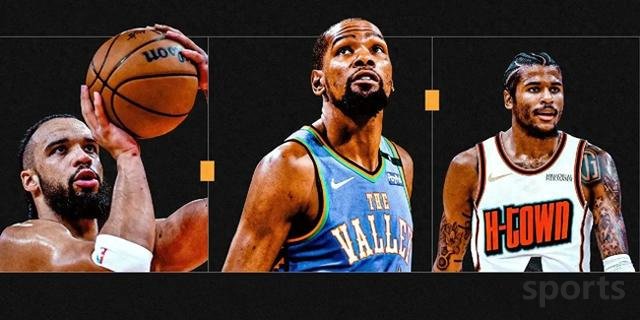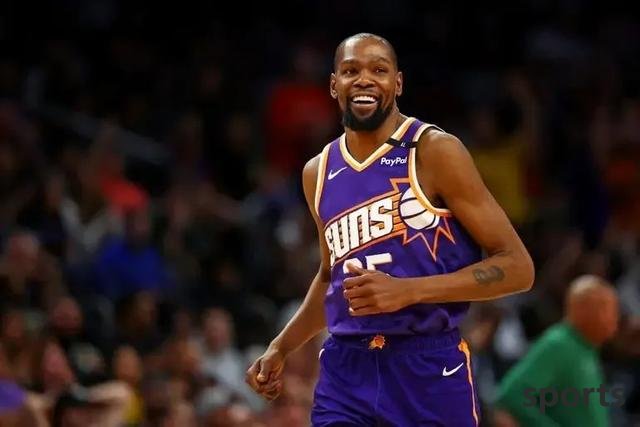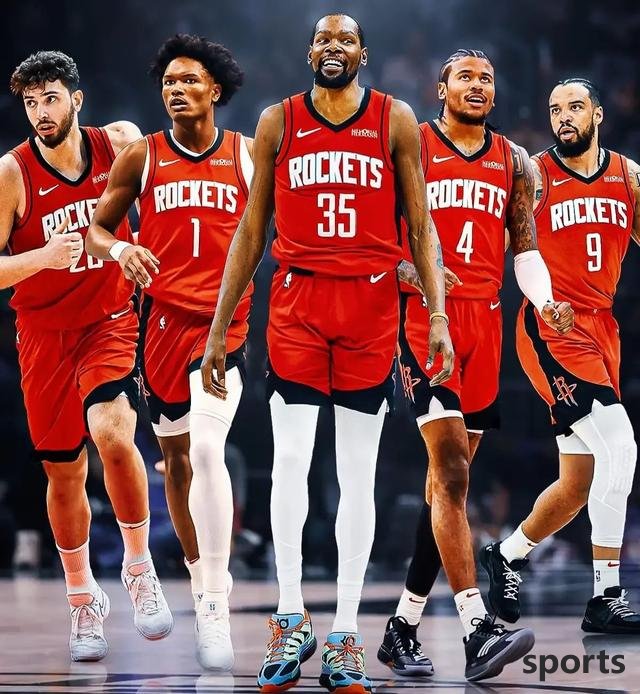289 Sports > Basketball > Durant joins the Rockets! Revealing how the 7-team big deal was made
Durant joins the Rockets! Revealing how the 7-team big deal was made

How was a deal involving seven teams facilitated? In fact, it is just like the old saying "eat the elephant in one bite" - starting with a scattered small transaction, it slowly pieced together into a big game.
As an industry insider who served as vice president of basketball operations for the Memphis Grizzlies from 2012 to 2019 and has participated in countless transaction negotiations, I can tell you: such large-scale transactions in the NBA are often a combination of several small transactions.
Let's start with the basics, which can help you understand the logic behind it: sometimes, it is more cost-effective for a team to make a multi-team trade score several times to complete the same transaction. Because in "simultaneous transactions", the special cases of transactions that can be obtained according to the labor-management agreement are more considerable than doing one transaction at a time (even if the two transactions are only a few minutes apart).
For example, before the 2016 trading deadline, the Grizzlies sent Courtney Lee to the Charlotte Hornets in exchange for Brian Roberts, P.J. Harrison and two second round picks. But the total salary of these two new players is lower than that of Li. According to the rules, we can put more salary in the transaction, and the team still had room for offline operation under luxury tax. So as long as someone is willing to "pay the bill", we have the motivation to bring more salaries in.
If you do the Lee for Roberts directly, the only difference in salary between the two people (at that time it was $1.6 million). But if Li was exchanged for multiple contracts at the same time, he could recover at most 150% of his salary (the regulations were as follows: later, the labor-management agreement was relaxed, and the new regulations in 2023 allow non-taxpayers to convert middle-class special cases into transaction special cases).
So we started looking for more salary combinations. The Miami Heat exceeded the luxury tax at the time and faced repeated penalties and urgently needed a salary cut. We had a talk to send Roberts to the Heat for Chris Anderson – who paid almost twice as much as Roberts, and in return we also got a second round pick and a protected second round pick. If it were to trade separately, Roberts would not be able to trade Anderson.
You see, a three-party transaction is done like this. The key is that this transaction meets the league's "relevance" requirements for tripartite transactions - there are direct player or asset exchanges between Memphis, Charlotte and Miami.
The starting point of a three-party transaction is often like this, and it is easy to get bigger and bigger. Let’s talk about the seven-team deal that involved Kevin Durant on Sunday was almost derived from five independent deals in draft week. The Atlanta Hawks, who joined the final, were the only ones involved in free agents. In theory, the other four deals can be made one by one, but for everyone, it is much more refreshing to package into a multi-team deal.

However, there are more than one way to form large multi-team transactions. Last year, Klay Thompson of the Golden State Warriors signed first and then switched to the Dallas Mavericks, and finally involved the six teams because each step was using the exceptions generated by the previous transaction to promote the next transaction. On the 2024 trading deadline, the four teams of the Warriors, Trail Blazers, Pistons and Hawks almost lost their trade because Gary Payton II failed the physical examination.
July 6 (the team can officially sign free agents) and trading deadlines are the most likely times for multi-team trades, and the reasons are exactly the opposite. Around July 6, the team had enough time to polish trades between draft picks and free agent market opening, and could merge the originally independent trades to maximize trading exceptions; at the deadline, it was because there was no time - even if you wanted to do it one by one, the league would not have time to complete the next transaction before the deadline.
Just to say that this offseason, Houston and Phoenix first talked about a direct deal: the Rockets gave the No. 10 pick, five second rounds, Dillon Brooks and Jalen Green, for Durant. But two weeks before the official execution, plus the entire draft process, the Rockets found that if they added a contract when the free agent market opened, and then La Atlanta came in to make Clint Capela's first signing and then exchange, they could get more salary. To meet the "relevance" requirement - each team gives and gets assets in the trade - the Hawks send two-way player Darkwan Prowden to the Suns, and the Rockets send two-way player David Roddy to the Hawks. Interestingly, these two players were cut immediately after the deal was completed.
The Suns started trading with the second round of sign-in exchanged from the Rockets on draft night, which became the fuse for the seven teams' trade. The No. 59 draw ranged from the Rockets to the Suns, to the Warriors, and finally to Memphis (the Grizzlies did not trade in the seventh team, and they were later made with the Warriors alone).
At the same time, the Suns sent their No. 52 draw to the Warriors for the No. 41 draw. In this way, the Warriors became the fourth team in the trade, satisfying the "correlation" through the draft picks between the Rockets and the Suns. The No. 41 Kobe Bria, the No. 52 Alex Tooch, and the No. 59 Jama Masak were all involved in the deal.
is not over yet! The Suns threw out the other two future second round picks they got from the Rockets, and exchanged the No. 36 pick from the Brooklyn Nets, then sent the sign and another draft pick to the Minnesota Timberwolves, and advanced to the No. 31 pick to choose Lasher Fleming. The Timberwolves sent the No. 36 draw to the Los Angeles Lakers, exchanged for cash and No. 45 draw (Roko Zikaski).
In this way, Brooklyn, Minnesota, and the Lakers also joined. The Lakers gave the Timberwolves cash and the No. 45 draw in exchange for the Nets' No. 36 draw (this sign was previously traded directly from the Bulls); the Timberwolves took the Lakers' No. 45 draw, the Suns' No. 31 draw, and also collected two future second rounds from the Suns; the Nets took the Rockets' two future second rounds and gave the Lakers' No. 35 draw.

There is a small question here: Why didn’t Memphis join and turned the trade into a team eight? The Grizzlies sent their No. 56 draw to the Warriors, and replaced the No. 59 draw and some compensation for the Rockets. According to my in-depth understanding, some teams may want to keep this transaction separately. If they want to make their own multi-team transactions in the future, they can still be used as a starting point..
There are similar situations in Thompson's deal in 2024, and it is more complicated and interesting - it is not the "bad-picking game" on talent night, but it is glued up with valuable transaction exceptions, which also shows that this kind of operation may be seen more in the future.
At that time, the Warriors and Buddy Heard's transaction was signed first and then exchanged, which helped the Philadelphia 76ers create a trading exception. In addition, the rules for trading exceptions were relaxed, and the Warriors could put Heard into Thompson's transaction and put another contract, so they added the sign first and then exchanged with Minnesota.
suddenly became a big deal for four teams, followed by the Thompson deal in Dallas: the Hornets gave Dallas two second rounds to exchange Josh Green, so that Dallas could make the Thompson deal a three-party sign and then exchange - as long as one of the second rounds ended up in the Warriors. With the clever flow of other second round picks, Minnesota and Philadelphia were easily pulled in.
The last stop was Denver, and they had their own deal with Charlotte: give two second rounds to the Hornets and throw off Reggie Jackson's contract. But one of the second rounds is destined to be sent to Dallas and then redirected, so Denver joined, and only the third team needs to give back something small (here is cash).
So, friends, this is how the sixth or seventh team trade comes. Most executives don’t wake up early and say “I want to make a seven-team deal” (I can think of two or three exceptions, they know who they are).
As I said before, I think there will be more and more such transactions. Unlike this year's seven-team deal, the future may be more like Thompson's deal in 2024, involving a large number of active players.
We have seen the multi-team trading in 2025. Next summer, get ready for popcorn and wait and see.
Related Posts
So what if he averages 4+1+1 per game? The main defender is retired, and the 21-year-old No. 1 player is sitting on the bench. He has a chance to make a comeback!
BasketballNot long ago, this season's NBA preseason games have ended. The Rockets, who have been crazy about signings this summer, did not have any surprises. In all four games, they won them all easily. And the scary thing is that in these games, the tea...
moreXia Ji: Caleb Martin and Buwe have participated in training and are expected to appear in the opening game
BasketballHupu News, October 19 Today, according to TA Mavericks reporter Christian Clark, forward Caleb Martin and defender Brandon Williams have participated in training and are expected to appear in the opening game. In addition, Daniel Gafford conducted n...
moreFamous reporter: James and his business partners have withdrawn from the new $5 billion international basketball league plan
BasketballOn October 19, ESPN reporter Brian Windhorst wrote an article reporting on the business plan of the Middle East consortium in the international basketball market. Windhorst mentioned in the article the new international basketball league plan that J...
more
Hot Posts
- Last season, averaged 9.7 points and 2.2 rebounds! Jersey Reporter: Coffey wore No. 17 jersey in the Bucks
- 18 years of the showdown in the league to looking up to the new king, the legend continues
- Durant himself never thought he could enjoy super high treatment in his life, but he came to the right place!
- The park championship has no value? American News: The Lakers have better psychological adjustment and beat many stars all the way
- As strong as Jokic is only the No. 41 pick in the second round in 2014. Who are the top five in the same class? Tanhua became an MVP
- Well-known reporter: The Lakers center may get a contract of 5.2 million, but he may still stay with the Lakers
- The logo of the NBA tough guy: Kobe s Achilles tendon, Rose s knees, Green s heart
- Top Ten Wicked People in NBA History: Dream Chasing Green is on the list, and there is no dispute!
- A wise man will make a mistake. James counts the 20-year trend of the league, but he has not counted these 5 things
- Three-point shooting percentage is 48.2%, top 3D with an average of 14+6 per game, and only 33 million yuan. Do you regret it, Celtics?
Recent Posts
-
The crack deepens! King James executes the 52.6 million option, and the Lakers respond silently!
-
Five signings in one night were achieved! 17 assists in the single game and the point guard joined the Magic, the Thunder signed the Belgian defender
-
Westbrook s surgery successfully welcomes rebirth! The Nuggets officially announced the signal to stay in the team, adding another key puzzle to the championship next season
-
The latest news from James and Doncic comes Doncic: I have speed. James: Hum?
-
115-131, Battle of Tianwang Mountain, Harden is once again awkward! Let’s see how media people from all sides comment
-
Butler was insulted by Timberwolves fans! He was mocked "Sourish General" and killed the old master by 20+11+8
-
The Xinjiang team almost made sure that foreign players released pigeons again, and this was once again being cheated by foreign players every year!
-
James historical status is very controversial, but he is one of the superstars who truly influenced the world s basketball.
-
It s a solid reputation! Wade claims to be the greatest star in the Heat s history, with confidence in three championships, James stands behind
-
100 million center is here, Lakers strengthen their inside shortcomings, Doncic s fellow villager may become a substitute